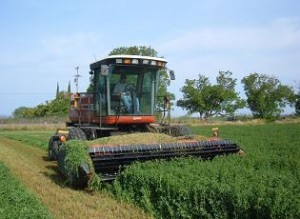25
Sep
USDA Refuses to Investigate GE Alfalfa Contamination
(Beyond Pesticides, September 25, 2013) Five days after genetically engineered (GE) alfalfa was confirmed to have contaminated non-GE alfalfa in Washington State, the U.S. Department of Agriculture (USDA) announced it would not investigate the incident. Conventional and organic farmers have long been concerned with the economic impacts of GE adulteration, and this incident represents the latest in a long string of contamination events that have brought a global spotlight on the United States’ loose regulatory structure for these controversial crops.
GE alfalfa is engineered by Monsanto to be resistant to glyphosate, or “Roundup Ready,” and is the first engineered perennial crop. The contamination could either be a result of cross-pollination or direct contamination of purchased seed. Cross- contamination is highly likely as alfalfa is pollinated by bees that can fly and cross-pollinate between fields and wild sources miles apart. According to a December 2011 report by Stephanie Greene, a Ph.D. geneticist with the USDA Agricultural Research Service (ARS), after Roundup Ready alfalfa was first deregulated in 2005 industry testing of conventional seed lots found levels of contamination as high as two percent.
USDA claims the contamination is a “commercial issue” and should be addressed by the marketplace and not the government. GE alfalfa contamination could have a dramatic impact on all alfalfa farmers. Alfalfa is the fourth-widest grown crop in the U.S. and has an export value of $1.25 billion dollars. The U.S. is the primary alfalfa supplier to countries like Japan, Saudi Arabia and other countries that prohibit and/or require labeling of genetically engineered foods. This incident comes on the heels of findings of wheat in Oregon that was contaminated with unapproved GE wheat, which has spurred several lawsuits claiming this incident has led to economic losses. After this contamination, Japan cancelled its order to buy U.S. western white wheat. These incidents bring into question USDA’s ability to regulate GE crops in way that is not harmful to non-GE farmers.
This contamination could also have a dramatic impact on the organic community. Alfalfa is the key feedstock for the dairy industry. GE contamination would cause organic dairies to lose their source of organic feed, a requirement for organic dairy, including milk and yogurt products.
GE alfalfa designed to be resistant to herbicides is unnecessary. USDA data shows that 90% of all the alfalfa planted by farmers in the U.S. was previously grown without the use of any herbicides, which the GE alfalfa is engineered to withstand. Due to the planting of GE alfalfa, USDA estimates that up to 23 million more pounds of toxic herbicides will be released into the environment each year.
Beyond Pesticides has a long history of fighting against the growing of GE alfalfa. After USDA first proposed complete deregulation of the crop in 2005, Beyond Pesticides joined with other environmental and farming groups in a lawsuit that argued that USDA did not adequately defend its decision to forgo an environmental impact statement (EIS). In 2007, a U.S. District judge ruled in favor of the environmental and farming groups, finding that USDA violated federal environmental law by failing to conduct an EIS. One of USDA’s chief arguments -that GE alfalfa will not affect the crop economically- was also rejected by the court. While USDA worked on the EIS, GE alfalfa remained unlawful to plant or sell, and a ban remained in place despite Monsanto appealing the case all the way to the U.S. Supreme Court.
In December of 2010, the Obama administration proposed limiting GE alfalfa to restricted planting zones to prevent contamination. The EIS was completed by USDA in 2011 and found that GE alfalfa, unless restricted, would contaminate natural alfalfa, cause the loss of U.S. export markets, dramatically increase pesticide use, and drive the rise of Roundup-resistant superweeds.
Despite this overwhelming evidence of harm, in 2011 USDA announced plans to fully deregulate GE alfalfa. The announcement came after U.S. Agriculture Secretary Vilsack signaled that he wished to seek a middle ground regarding the crop, exclaiming that organic, conventional, and GE farmers could coexist. After a series of meetings and discussions among stakeholders, the agency’s final decision infuriated organic farmers and environmentalists, who felt the agency ignored their concerns. The concerns were expressed in a 2011 open letter to USDA.
Beyond Pesticides, along with other environmental and farming organizations, filed a suit in March of 2011 challenging the agency’s deregulation of the GE alfalfa. The suit, Center for Food Safety, et al., v. Vilsack, et al., argued that the agency’s deregulation of the Roundup Ready alfalfa is unlawful, and tried to prevent any further planting of the engineered crop. However, in 2012, a U.S. District Judge in San Francisco issued a ruling finding that USDA’s decision to deregulate GE alfalfa was not unlawful.
For more information on this issue, see Beyond Pesticides’ webpage on genetic engineering and see our related Daily News entries.
Source: Reuters
All unattributed positions and opinions in this piece are those of Beyond Pesticides.











The USDA is no longer there to protect the public. They pander to corporations. Very sad because this is definitely not what the agency was established for in the first place.
September 25th, 2013 at 9:37 amWho made this decision?
Does this person have ties to Monsanto?
Was this person bribed?
Why isn’t GMO contamination a national security concern?
When will the American People demand an investigation of the USDA?
September 25th, 2013 at 3:24 pmCorrupt government agencies are killing this country. I am heartsick over the loss of my nation to thieves and cheats, liars and psychopaths, greedy guts and genocidal maniacs. Not much fun being an American these days … not if you have a conscience.
September 25th, 2013 at 3:29 pmIs there a petition or some action we can take to get the USDA or some agency to investigate this contamination?
September 25th, 2013 at 7:44 pm